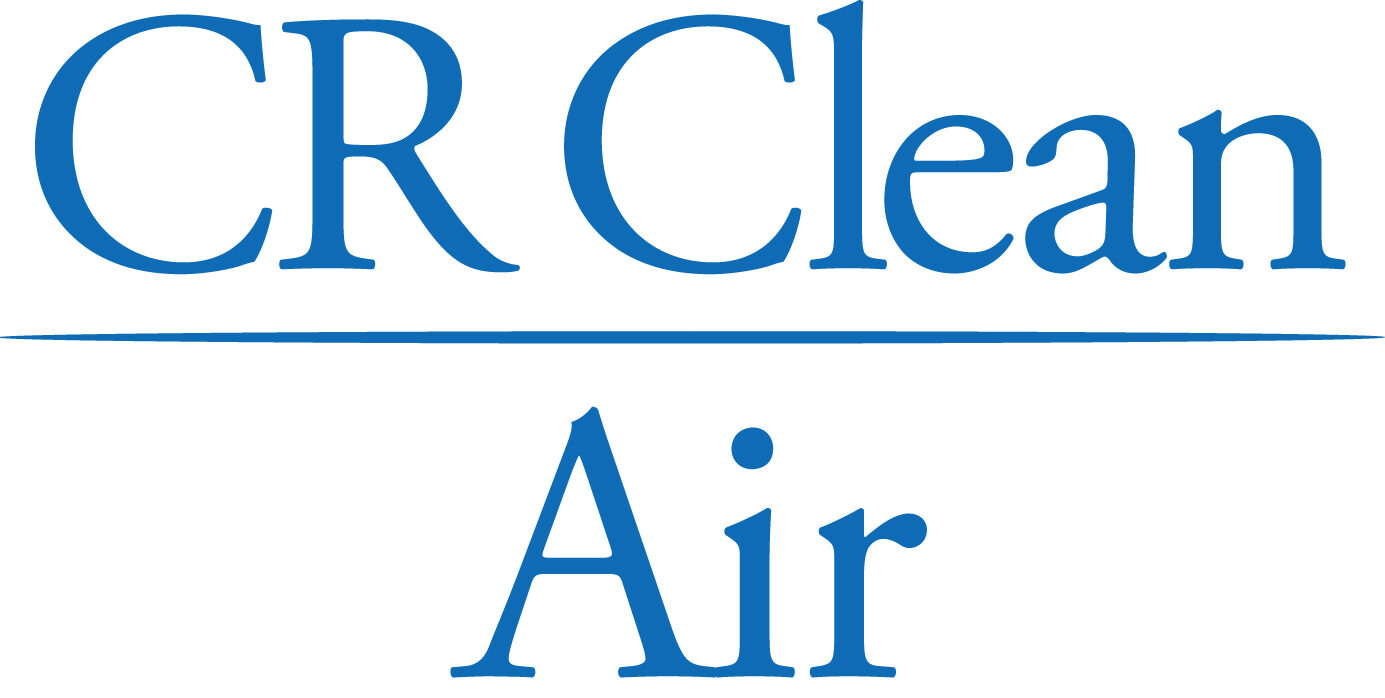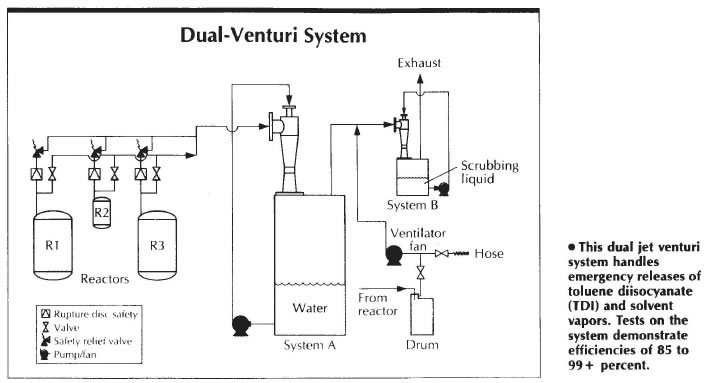Air-scrubbing venturis and towers may be the answer to clean air compliance for small- to medium-sized companies.
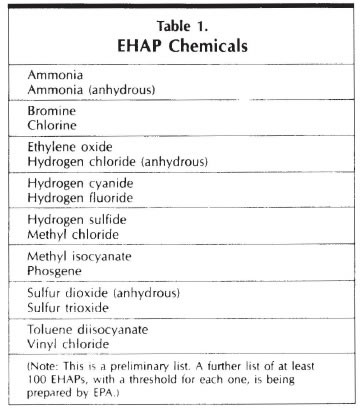 Forthcoming requirements of the Clean Air Act Amendments of 1990 will inventory many more specific chemicals considered hazardous. From acetaldehyde to xylenes, the list regulated under the air taxies program includes 189 hazardous air pollutants (HAPs). That number may grow.
Forthcoming requirements of the Clean Air Act Amendments of 1990 will inventory many more specific chemicals considered hazardous. From acetaldehyde to xylenes, the list regulated under the air taxies program includes 189 hazardous air pollutants (HAPs). That number may grow.
The Environmental Protection Agency (EPA) intends to add another 100 or more chemicals under the “prevention of accidental releases” program dealing with releases of extremely hazardous air pollutants (EHAPs). A preliminary list of EHAP chemicals is given in Table I . Any company producing, using or handling more than threshold quantities of one of these substances will be mandated to have an approved release prevention and control program.
While EPA has yet to establish threshold quantities, the fact that these limits will be based on toxicity. flammability and amount of the substances known to cause serious adverse effects to human health implies that the incineration. thresholds will be low. Remediation measures probably will be required for most producers and users of EHAPs.
In the past, local jurisdictions were left to decide whether certain chemicals were emitted in sufficient quantity to need treatment. New regulations. however, give EPA the final word. Relatively small sources – 10 tons per year of any HAP – will come under designation as “‘major sources.” while lower levels of emissions will be addressed as “area sources.”
In addition to tightening requirements, the Clean Air Act amendments also significantly strengthen penalties for non-compliance, up to and including personal liability for violations .Maximum achievable control technology (MACT) is required by the Clean Air Act amendments. Producers and users will be required to meet MACT standards within three years after the standards are set. There is, however, some leeway with alternative emissions limitations. Existing sources of HAPs that achieve an early reduction in gaseous emissions of 90 percent, or a 95 percent reduction in particulates, before the standards are set, can apply for a six-year extension of the MACT deadline.
Maximum achievable control technology (MACT) is required by the Clean Air Act amendments. Producers and users will be required to meet MACT standards within three years after the standards are set. There is, however, some leeway with alternative emissions limitations. Existing sources of HAPs that achieve an early reduction in gaseous emissions of 90 percent, or a 95 percent reduction in particulates, before the standards are set, can apply for a six-year extension of the MACT deadline.
Reviewing Available Control Strategies: There is a tendency to think in terms of dry control strategies for dry contaminants. Physical collection methods include fabric filtration and electrostatic precipitation. Destruction or waste-to-energy methods include conventional. regenerative and catalytic incineration.
Many process industries find that a wet form of pollution control is a cost-effective alternative. Because of the nature of the process operation, wet scrubbing with waste-water generation – the classic dry/wet, gas/liquid situation – is used.
A pollution control system should fit the plant’s existing operating and maintenance procedures. For example, a wet scrubber generally has a wet by-product. Offending fumes, dust and other particulate, airborne toxics, etc. are knocked down into a fluid stream for collection, conversion to harmless substances, or further treatment in the plant’s existing wastewater system. In many cases, the control method also becomes a method of source reduction as the reclaimed material is recycled into the process.
Another point in favor of a wet system is its relatively simple operation and technology. In most instances, process/production and maintenance people already are familiar with wet systems. The venturis and towers are much like the plant’s existing piping, pumps and process towers.
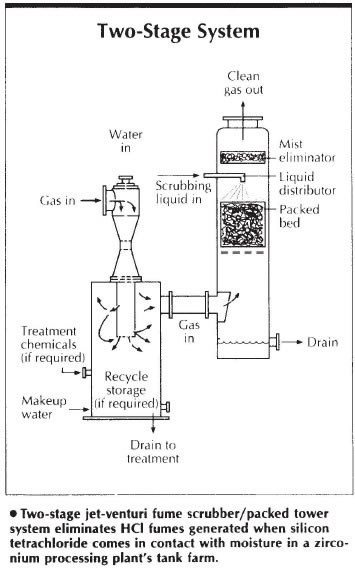 Selecting A Wet Scrubber: Wet systems for air pollution control include wet scrubbers of the conventional high energy venturi type, jet venturi (ejector scrubber) type, wet cyclone type, and scrubbing towers of various types and combinations such as packed towers, tray towers, spray towers and impingement towers.
Selecting A Wet Scrubber: Wet systems for air pollution control include wet scrubbers of the conventional high energy venturi type, jet venturi (ejector scrubber) type, wet cyclone type, and scrubbing towers of various types and combinations such as packed towers, tray towers, spray towers and impingement towers.
The jet-venturi fume scrubber works on the principle of an ejector, entraining and scrubbing large volumes of gas without baffies or moving parts. Motivating fluid enters the scrubber from a nozzle in a hollow cone spray, creating a draft that draws the gases and vapors into the moving stream where they are continuously scrubbed or absorbed.
Basic design of the packed-tower type scrubber is counterflow. The stream of gas to be scrubbed enters the bottom of the column and works its way upward through a bed of packing designed to provide a high surface area. The scrubbing liquid may be distributed through a full-cone spray nozzle or other device over the surface of the packing and flows downward by gravity – countercurrent to the gas. This allows the fresh water to contact the exit gas having the lowest pollutant levels, assuring optimum mass transfer and resultant removal.
Very often a given scrubbing job could be handled by either a jet venturi or a packed tower. The jet venturi requires more energy input than the tower, and is usually somewhat less efficient because of limited contact time between liquid and vapor. A packed tower, providing much greater contact time, can offer better than 99 percent removal. On the other hand, a tower usually has a more limited turndown, so ensuring its effective performance over the desired range of operation requires considerable technical expertise.
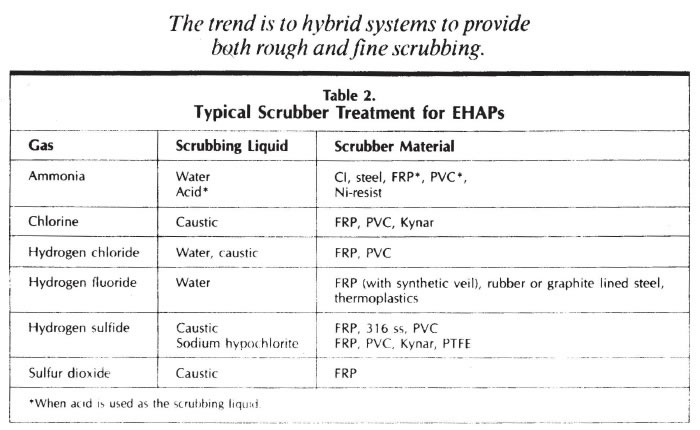 The trend is to hybrid systems using venturis or cyclones plus scrubbing towers and mist eliminators. or a combination of various types of venturis or towers. This combination provides both rough and fine scrubbing to achieve highest efficiency, and is effective for mixtures of gases or gases and particulate.
The trend is to hybrid systems using venturis or cyclones plus scrubbing towers and mist eliminators. or a combination of various types of venturis or towers. This combination provides both rough and fine scrubbing to achieve highest efficiency, and is effective for mixtures of gases or gases and particulate.
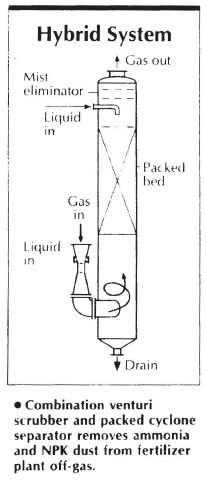 In selecting pollution control equipment, certain parameters must he met. The prime requisite is technology that meets performance and capacity requirements. Ask the supplier for a list of satisfied customers with requirements similar to yours and communicate with several of the companies.
In selecting pollution control equipment, certain parameters must he met. The prime requisite is technology that meets performance and capacity requirements. Ask the supplier for a list of satisfied customers with requirements similar to yours and communicate with several of the companies.
Characteristics of the gas to he handled affect the selection of pollution control equipment. If the gas has explosive components or is flammable, a wet. quenching process is usually safer.
Construction must be suitable and materials should promise a reasonable life. Table 2 shows typical scrubbing solutions and materials of construction for scrubbers to handle EHAPs.
Scrubber technology is particularly applicable to control of emissions and accidental releases in areas such as specialty chemicals and pharmaceuticals: laboratory and R&D applications where experiments may discharge toxic gases: chemical process off-gases such as reaction off-gases, tank or reactor vents: and off-gases from small- and medium-sized industrial incinerators.
Scrubbers are most effective for capacities ranging from less than I 00, up to 20,000 or 40,000 cfm. Compact packaged systems are usually available up to 10,000 or 15,000 cfm.
Pollution control equipment should be treated just like the plant’s revenue producing process equipment. Scrubbers require care similar to pumps or distillation columns, including yearly maintenance turnaround with inspection of beds, spray nozzles, critical internal dimensions. etc. Remember that pollution control equipment is usually custom designed and as with all process equipment, timely preventive maintenance will in the long run. save both money and time over emergency repair and replacement.
